If you’re baffled by the “co-sleeper vs. bassinet” dilemma, I have two things to say to you:
One – you’re not alone.
It’s one of the most common questions any (responsible) new parent has.
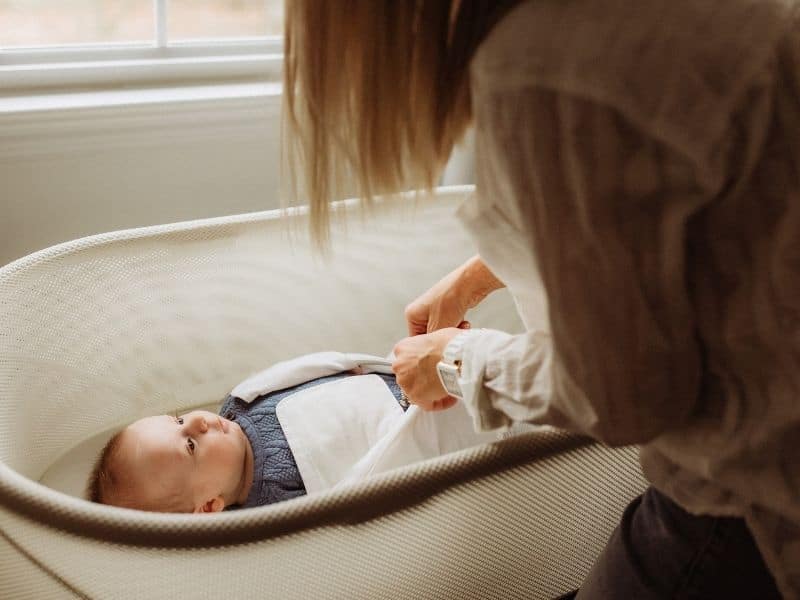
Two – kudos for taking the time to research. Choosing right here can make all the difference down the line.
My goal today is to offer comprehensive information on all key aspects of the decision so that you can make it fully informed.
That’s why I’ll start broad and zero in on the most important points as we move along. Bear with me.
On co-sleepers
Co-sleeper is a name used for any piece of baby gear that allows you to sleep with your baby without them actually being in your bed (which you should never do…but more on that in a minute).
It’s basically an extension for your bed.
By far, the most common type of co-sleeper is the bedside sleeper. This is your typical bassinet-style baby bed that is attached to the side of your bed.
It’s probably what you have in mind when you hear the word “co-sleeper.”
For more detailed info, read this guide on what is a co-sleeper.
Co-sleeper or bassinet – how are they different?
Compared to a bassinet, a co-sleeper is bigger, one side is almost always collapsible, and the height is adjustable.
You’ll notice that all of the main features of a co-sleeper are about easy access to the baby. If that’s important to you, you probably have the answer to the “co-sleeper vs. bassinet” dilemma early on in the article.
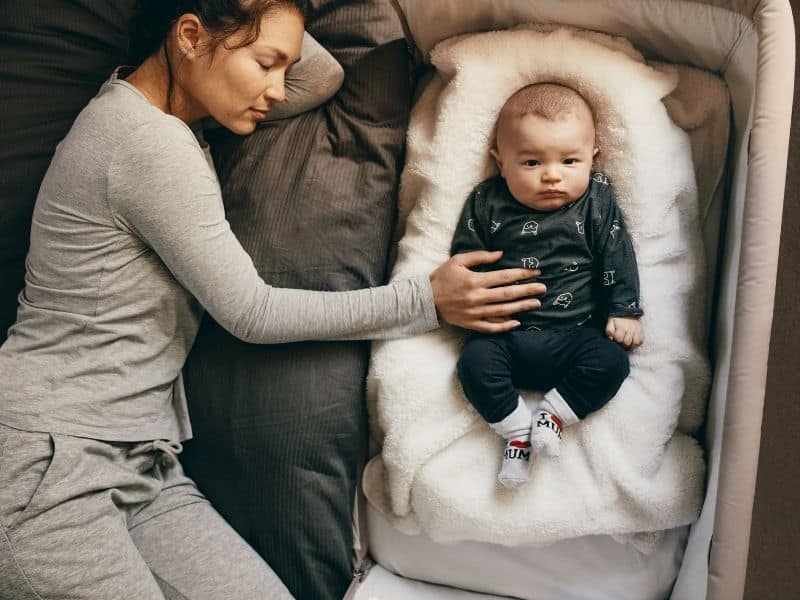
If the baby is breast-fed or mom’s movements are limited for whatever reason (like recovering from a C-section), a well-chosen co-sleeper will outshine a bassinet every time.
Accent on the “well-chosen bedside sleeper”
I’m stressing the “well-chosen” part because more moving parts (compared to a bassinet) mean there are more things to get right.
- The right has to be just right to be a good fit for your bed
- The mechanism of attaching the co-sleeper to the adult bed should be absolutely safe, and the connection should be snug
- There should be no loose parts inside the co-sleeper
- At least one of the walls should be easily collapsible and still sturdy when up
- The height should have a decent range of adjustment (I wouldn’t go below 8 inches, the better ones are in the 10 to 12-inch range)
- The base of the co-sleeper should be designed so that it can seamlessly slide under the bed, even if your main bed’s frame is not raised
You can tell by now that there’s more to choosing a good newborn bed than deciding between a co-sleeper and a bassinet.
For specific recommendations, see this guide on best co-sleepers.
Are co-sleeper bassinets safe?
Co-sleepers are safe as long as you follow a few guidelines that I’ll outline below:
- When using a co-sleeper, choose more rigid covers and pillows for the adult bed. Avoid anything flimsy enough to find its way into the baby’s area. This includes thin covers, blankets, and pillows.
- There should be no detachable toys or anything else the baby can get its hands on, turn it into a chew toy and a choking hazard
- The connection between the co-sleeper and your bed should be secure and snug so that nothing can get in-between. Think sturdy and tight because loose and flimsy means an increased risk of a gap appearing between the beds, sometimes big enough for the baby’s arm or leg to get stuck.
Read more on co-sleeper safety here.
Is a co-sleeper a bassinet?
Strictly speaking, a co-sleep is not a bassinet; it’s an alternative to a bassinet that allows you to share a bed with your little one without “actually sharing a bed.”
Let me explain what I mean by that.
Co-sleeping is not bed-sharing
While a co-sleeper securely attaches to your bed, it is a separate sleeping surface, which is the crucial point.
Why?
Because bed-sharing in those first feeble months, tempting as it may sound, is dangerous.
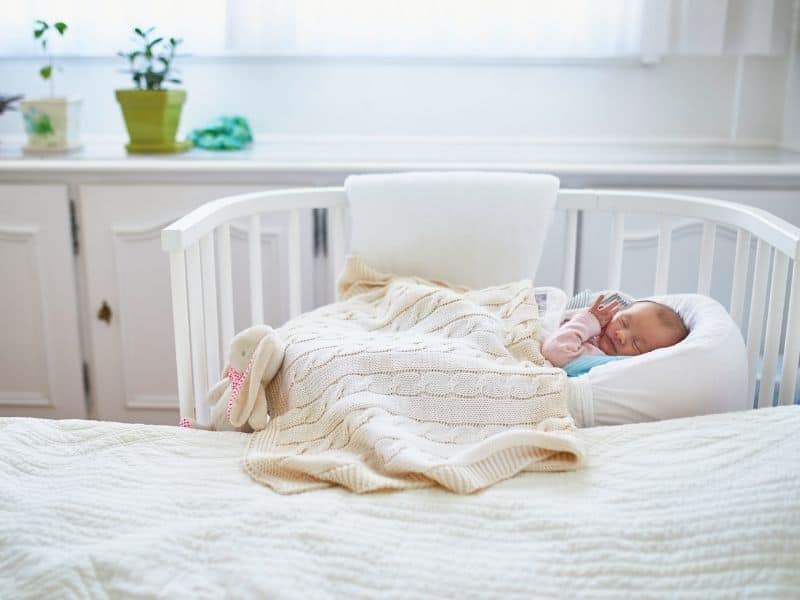
No two ways about it.
Some of the risks of bed-sharing are:
- Suffocation resulting from loose bedding – I mention that loose corners of bedding are a hazard even when the baby is in a co-sleeper. That risk turns red hot the moment you place a baby in your bed. It should only happen if everybody is awake and well aware of the surroundings. And yes, that means no naps either.
- Crushing the baby with your weight – think back to when your partner told you that you’re wondering limb hit them across the face. Imagine that happening with your baby. Worst case scenario, you can roll all of your exhausted weight onto them.
- Falling off the bed – even if they can’t move on their own, a baby sleeping with adults is at risk of falling off. It can be as simple as nudging them away.
- Insufficient sleep – it might feel comfy but imagine lying in bed after reading grim warnings like the ones above (and I intentionally made them grim). You’re not likely to get quality, deep sleep. The parents who know the risks and still try it talk about being half-asleep and waking up in the middle of the night and never really drifting off because they are too aware to relax.
Bottom line – you shouldn’t do it, especially when you know that you can get all the same benefits from using a bedside sleeper.
Even when you do eliminate most of the risk of bed-sharing by getting a co-sleeper, chose one that as many (all, if possible) of the general safety precautions:
- Baby should sleep on its back
- The surface should be flat and firm with minimum “give”
- Tight fit between the bed and the foot and headboard
- Tightly fitted bedding
- No loose toys or pillows
- No space around the mattress and any adjoining rail or wall
The American Academy of Pediatrics does recommend room sharing as the safest sleeping arrangement, and you can do it with co-sleepers, regular or bedside bassinets, but don’t sleep in the same bed.
On bassinets
A bassinet is a baby bed designed to be used in those first 4-5 months. They’re often confused with cradles and cribs but they’re not the same thing (you can read more on the differences here).
They’re a typically lighter, portable, and less expensive alternative to cribs…at least that used to be the case.
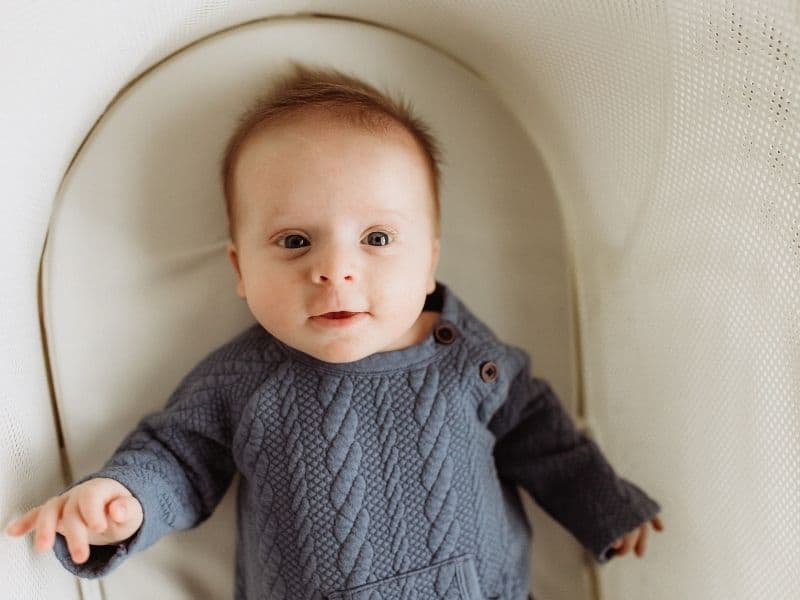
Over the last decade, however, the smart bassinet industry has made giant leaps, and you can now opt for a bassinet that will not only be completely safe and soothe the baby but even recognize when they wake up in the middle of the night.
Now, that kind of sleep “luxury” doesn’t come cheap. Still, there are some solid budget solutions out there, you can see my top choices in the budget bassinet category here.
Their main advantage of bassinets over co-sleepers
The best bassinets today can do more for new parents than co-sleepers.
Apart from putting the baby to sleep faster through vibration, movement, and sound – a smart bassinet will keep the baby sleeping when they would’ve otherwise woken up.
“How?” you ask.
The high-end bassinets are equipped with sensors that recognize movement and fussing and initiates a soothing protocol of gentle swaying and vibration (you can see my top picks among smart bassinets here and best vibrating bassinets here).
All the tech aside, babies prefer smaller comfy spaces because they feel safer and sheltered. That’s true up to the age of 3 (Reuters).
Related reads:
Co-sleepers and bassinets – who’ll choose what?
Most of the information I found on the topic was vague at best and blabbering on at worst. I’ll try to change that and be as precise as I can.
Who’ll choose a co-sleeper
You’ll choose a co-sleeper if:
- Being close to your baby and feeling their physical presence is critical for you
- You are breast-feeding and/or moving around is difficult (recovering from a C-section)
- You love the convenience of not leaving the bed to hold your baby
Some deal-breakers of a co-sleeper
Stay away from a co-sleeper if any of the factors below are a deal-breaker:
- Co-sleepers are big compared to a bassinet. Whether you go with in-bed or bedside co-sleepers, space will be a factor. With the former, it’s about the bed surface, and with the latter, it’s about the room space. Before getting a co-sleeper, do some math on how it fits your room You can see my list of best bassinets for small spaces here).
- They can add to sleeping problems. If either of the parties involved is a restless sleeper, they’re not likely to get quality shuteye in a co-sleeping environment.
- You’re likely to have a harder time teaching the baby to self-soothe. If a baby gets used to your presence, getting them to a crib when the time comes might be more challenging.
Who’ll choose a bassinet
You’ll choose a bassinet if:
- Portability is important. Bassinets are lighter and easier to move around the house and even take on a trip.
- You’re not big on attachment and want to teach them self-soothing early on.
- Your baby is a restless sleeper that needs constant attention. This one is a no-brainer – if your baby has trouble sleeping and a swaying, vibrating bassinet soothes, cross a co-sleeper from your list of options.
If you are Ok with not having direct contact with your baby at all times, there’s probably only one deal-breaker when it comes to bassinets.
The price and limited use
If you go with a high-end bassinet, you’ll be paying a premium price for something you’re be using for 4-6 months.
If you ask me, it’s worth every cent and pays dividends in sleep hours, but it is a significant investment. If that’s your deal-breaker, they do come in all shapes and sizes (and price points), and you’ll likely find one that fits your budget with a bit of research.
Takeaways
There’s no one-size-fits-all answer to the dilemma from the title.
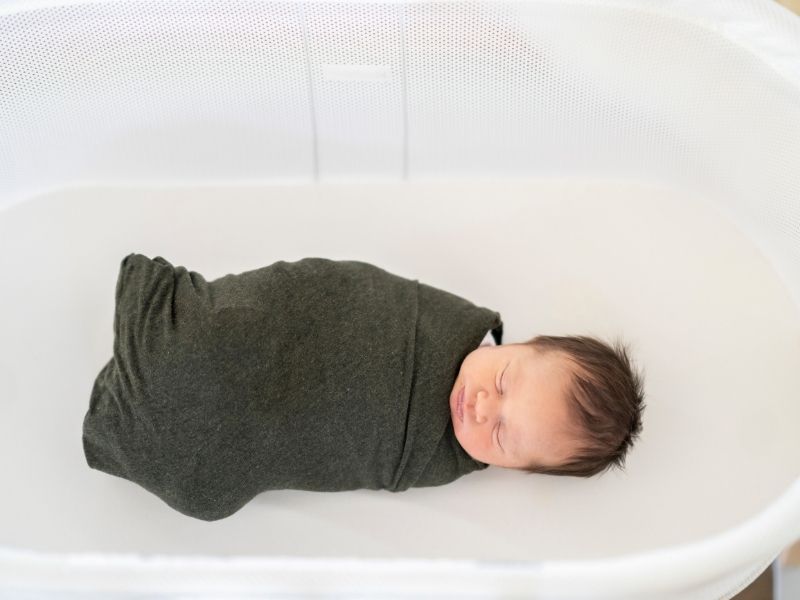
Hopefully, I did a good job of concisely guiding you through the pros and cons of the two options, and you can now make an informed decision.
Paul is a passionate dad who founded Upside Dad to share his parenting journey with other new parents. He graduated from Concordia University and worked as a test engineer for over a decade. Paul loves dad jokes and craft beer.
Learn more about Paul and Upside Dad here.
